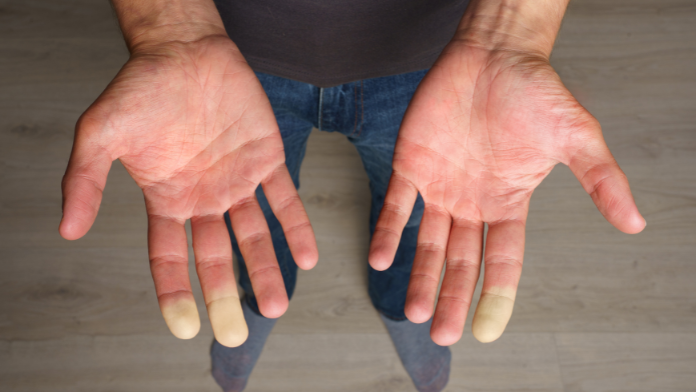Who hasn’t had, especially in the harshest seasons, cold hands with fingers that were first white and then purple and not very sensitive? Nothing alarming: this symptomatology is the result of an excessive response of the body to environmental stimuli, just like low temperatures. However, when these episodes involve the fingers of both hands symmetrically and occur even when there is milder weather, then you should become suspicious and contact your doctor.
It could, in fact, be the Raynaud’s phenomenon, a fairly common manifestation among the population and visible at a quick glance. Fingers and toes become first pale and whitish, then blue-purple or redtaunting intense tingling and painas recalled by the Italian Foundation for Research in Rheumatology (FIRA).
This color change is caused by a reduction in blood flow to the extremities of the body, it can last from a few seconds to a few minutes and can repeat several times in a row.
Primary Raynaud’s phenomenon
In most cases Raynaud’s phenomenon is primary, i.e. not associated with any other pathology. It is estimated that approximately 5-10% of the population suffers from this form, which is generally not very serious; it is often found in young girls and appears around the age of 14-20. In this case the disorder does not appear to be a prelude to other diseases, so much so that it can even regress without any treatment.
Secondary Raynaud’s phenomenon
However, there are cases in which Raynaud’s phenomenon presents itself as a warning sign of another connective tissue pathology, often accompanied by other symptoms. Among these are:
the “sausage fingers”, i.e. the swelling of the fingers and toes which makes the skin look shiny; the extremities that often have a tendency to ulcerate near the nail or on the fingertip; L’inflammation of the joints which may appear swollen, hot and cause pain; there texture of the skin which becomes stiff and thick.
Alarm bell for rheumatological diseases
«In this case we are talking about Raynaud’s phenomenon secondary which in 90% of diagnosed cases is related to so-called connective tissue diseases including systemic sclerosis (or scleroderma), the systemic lupus erythematosusl’rheumatoid arthritisSjogren’s syndrome, dermatomyositis and polymyositis», says Serena Guiducci, Associate Professor at the University of Florence, Director of SODc Rheumatology at the Careggi Hospital and member of the Scientific Committee of FIRA.
Warning bell for cardiovascular diseases (and more)
«Raynaud’s phenomenon can also be caused by vascular pathologies of compressive or inflammatory origin, vaso-occlusive, such as thrombophilic alterations and paraneoplastic phenomena. The causes also include pulmonary or cardiovascular diseases, chemical substances and drugs, such as beta blockers”, continues Guiducci.
The tests to be done to diagnose Raynaud’s phenomenon
To define the nature of Raynaud’s phenomenon it is necessary to carry out some tests:
the videocapillaroscopia periungueale: a non-invasive test that allows you to identify any deformities or enlargements of the capillaries; The antinuclear antibody testing, to check for an alteration of the immune system, common in connective tissue diseases or other autoimmune disorders; there erythrocyte sedimentation ratea test that determines how quickly red blood cells sink to the bottom of a test tube and may reveal an underlying inflammatory or autoimmune disease.
In this way, already making a distinction between primary or secondary Raynaud’s phenomenon, it will be possible to proceed with a specific diagnostic path.
How to treat it
The treatment of Raynaud’s phenomenon essentially depends on the presence or absence of a systemic disease as the underlying cause. As FIRA reminds us, it is indispensable reduce or eliminate risk factors, such as cigarette smoking, the use of substances with vasospastic activity (e.g. coffee), emotional stress and exposure to cold. In more severe forms it can be recommended the use of oral systemic vasodilators (calcium channel blockers), anti-aggregating agents or infusion vasodilators.
